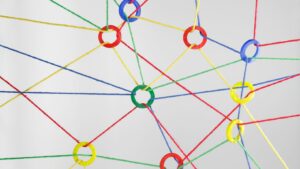Diving into the world of data, one can’t help but encounter the fascinating field of graph relationships. They’re the backbone of many complex systems, mapping out connections in a way that’s intuitive and revealing. From social networks to biological systems, graph relationships offer a unique perspective on how elements interact.
Graph Relationships
Graph relationships, also known as edges or links, represent the associations between distinct nodes in a graph. As an example, in a social network graph, nodes depict users and relationships illustrate connections between these users. Likewise, in a biological system, nodes could denote genes, where their interactions constitute the relationships. In essence, the primary purpose of a relationship in a graph is to indicate interconnectedness between nodes, mainly shedding light on the pathway of interaction or the strength of the connection.
Types of Relationships in Graphs
-
 Directed Relationships: These relationships suggest a unidirectional link between two nodes. For instance, Twitter’s “follow” feature signifies a directed relationship, as one user following another doesn’t necessitate the second user following back.
Directed Relationships: These relationships suggest a unidirectional link between two nodes. For instance, Twitter’s “follow” feature signifies a directed relationship, as one user following another doesn’t necessitate the second user following back. - Undirected Relationships: In contrast, Facebook’s “friend” feature is an example of undirected relationships, where the connection between two nodes is mutual, indicating bi-directional interaction.
- Weighted Relationships: Weighted relationships are those where numbers, or weights, assign significance to the connections. For instance, the frequency of interactions between two users on a social network may act as a weight.
- Unweighted Relationships: Conversely, unweighted relationships denote interactions where all connections hold equal significance, without any weight linked.
The Importance of Graph Relationships in Network Analysis
Networking and Connectivity
In network analysis, graph relationships play a pivotal role. They allow the comprehension and interpretation of complex systems, especially in the realization of patterns and structures. For instance, analyzing social media networks needs understanding graph relationships. Users represent nodes, and their interactions — likes, shares, and comments — symbolize edges. Tackling these relationships facilitates the comprehension of user behavior and identifies influential figures, if any.
Pathfinding and Flow Maximization
Furthermore, graph relationships contribute immensely to pathfinding and flow maximization. For example, in logistical networks, nodes represent geographical locations, and edges might represent the routes between these locations. By studying these relationships, firms can optimize their routes leading to reduced costs and increased efficiency. Another example lies in data networks, where nodes might signify computers or servers, and edges illustrate data paths. Through understanding these graph relationships, IT professionals can optimize data flow, thereby enhancing system performance.
Graph Databases and Their Uses
Storing and Querying Complex Relationships

Graph databases store data as nodes and the relationships between these nodes as edges. In a sense, they’re mimicking the natural organization of data in genuine network systems, such as social media platforms or transport networks. That’s why graph databases excel at managing intricately connected data.
A query on a graph database, unlike traditional databases, can efficiently unravel the complexity of relationships with direct connections. Take, for instance, a social networking platform that needs to identify influencers who are directly or indirectly connected to a significant number of users.
Real-World Applications of Graph Databases
Graph databases find many applications in real-world scenarios. Social network platforms like Facebook and Twitter utilize these databases to understand and optimize user interactions, creating personalized experiences. For instance, Facebook’s complex social graph, representing over 2 billion users and their relationships, is housed within a graph database for efficient management and querying.
In the scientific domain, biological researchers utilize graph databases to understand intricate biological relationships, such as protein-protein interactions or genetic links. The database straddles the relationship between various species, traits or DNA sequences making it easier to query and understand these complex relationships.
All You Need To Know
Understanding graph relationships has been shown to be key in making sense of complex systems. They’re pivotal in interpreting user behavior in social networks and species interdependence in biological systems. They’re also instrumental in pathfinding and flow optimization within logistical and data networks.

